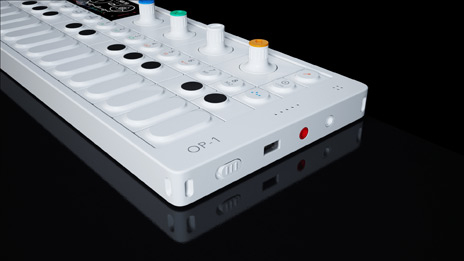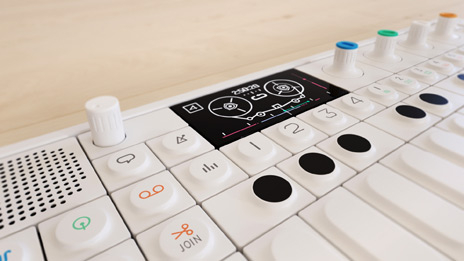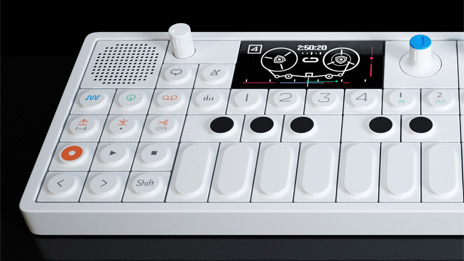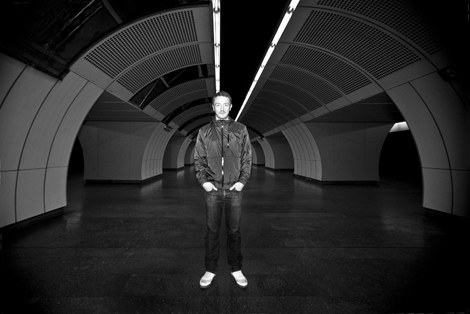



Bergerac presents Red Rack'em: Redportage 6 - Mike Huckaby Interview from selective pressure + on Vimeo.





Composer and sound designer Diego Stocco, seen often in these parts, has an endlessly-inspiring approach to inventing new timbres. That process of, as he puts it, “bringing music into the process of creating sounds” is sometimes destructive – as in, sawing an instrument in half destructive. It seems often at the edge of obliterating the object, but sliced thinly onto the side of unleashing its auditory potential. Sometimes, it’s gentle, putting an ear to the world. But his work is always exploring new frontiers of possibility.
Diego himself comes to the microphone to explain his philosophy and background in a fantastic interview launching a new video series, entitled Take, produced by the LA-based FIDM Digital Arts:
Take 5 with Sound Designer Diego Stocco [FIDM Blog; more digital artists and directors and such to come in that series]
Diego also sends CDM some of his latest work, an eerily-ethereal reconception of the sound of a filling oxygen tank, which becomes in turns percussion or vast, imagined space calliope.

Oliver $’s “Doin’ Ya Thang,” with its generous samples of Moodymann’s signature patter, has caused quite a stir since being released in April on Play It Down. While club audiences, Beatport shoppers and RA charters ate it up, many (including our own reviewer) felt the track exploited Kenny Dixon Jr.’s bountiful personality without giving him any credit. So when LWE was offered the opportunity to interview Oliver “$” Siebert, we knew it was important to ask the man responsible about the arrangements, motivations, and ethical quandaries behind one of 2011′s most notorious records.
I only have a few questions, and I actually primarily wanted to focus on your track “Doin’ Ya Thang.” Because I know that’s been a really big track for you, and it’s the one that’s of the most interest to us. I wanted to start by asking you what your thinking was behind the track when you were making it?
Oliver Siebert: To be honest with you, it was that kind of, like, quick ones. I mean, I basically heard that vocal and I thought, “Well, I have to use that.” I tried to produce a really nice DJ tool. It was not really, like, where I thought, “It’s my next single,” or something really big. I just made it like my other records.
So you would say it was pretty similar in the way that you made it to your other tracks, then?
Yeah, most of my stuff are DJ tools, and this one is a tool as well so.
Were you intending to release it, or was it originally something you were just going to originally save for your own sets?
First I just had it in my own sets, and then I showed it to Jesse [Rose, of Play It Down] because I just thought maybe it’s a nice bootleg idea or something. But that was like the very first version, and there was a lot of more talking in there. So I basically cut it down to the max. [laughs]
I see. So I was curious, did you ask Kenny Dixon Jr. or the promoters that the vocal was sampled from to use the — did you ask their permission to use the recording?
Not really. [laughs] To be honest, they’re clearing it right now — and the thing is in the beginning we thought, “OK, that’s a little thing for us to play out,” but nobody thought [about] it getting that intense, you know?
Yes, I understand. That being said, the track has caused a little bit of an uproar, especially among our readers, mostly because of the extensive use of Kenny Dixon Jr.’s vocals. And some people thought — and I know you weren’t thinking, necessarily, that it was going to be a track you were planning on releasing — but you took advantage of his live performance for your own benefit. And I was curious what you thought about that sort of reaction to your track.
Um, yeah, to be honest, man — I don’t know why it blew that crazy up, but in the end of the day it was just a quick idea, and Jesse liked it very much, and, yeah, that’s basically it.
I can understand that. Even still, though, after you and Jesse talked about it, obviously it became commercially available, and it did quite well on Beatport. And I think maybe the reason why some people have been maybe a little upset by it is because it’s mostly his vocals — with your beat — but it’s mostly his vocals that sell the track. When you were working on it and when you were deciding on whether or not to release it, did you feel any ethical concerns about whether or not to put out a track that was based mostly on Moodymann’s vocals?
Yeah, I mean you’re right — it’s definitely living out of the vocal, that’s for sure. But I never thought it’d go that big, and I thought, like, “Well, maybe we sell our 200 vinyl copies, and then maybe just a few digital things. [laughs] It’s quite crazy how that track blew up, I know exactly what you mean. That track is living out of the vocal and it’s basically my beat, and yeah, it’s really hard to say like– I mean, the vocal is definitely 60 percent, I would say, of the whole production. Yeah.
Would you say that when you’re producing, or when anyone’s producing, do you believe that anything is fair game for sampling, whether it’s someone else’s performance or someone else’s beat or –
To be honest, look at Kenny Dixon Jr.’s productions, you know what I mean. So he’s basically living that what I’m doing, you know.
Yeah, that’s true.
He sampled Chic, he sampled basically everything; and I guess that’s kind of an art, to grab samples from everywhere and just create something new out of it. That was basically my style back in the days when we started with that fidget house thing, and basically we grabbed samples from everywhere, and tried to make them a bit fresher, cut them up just a bit, and twist them, and — yeah.
That’s understandable. I guess the distinction some people would draw between some of Moodymann’s productions is that although a lot of them had identifiable samples — especially his Chic samples and stuff like that — a lot of them weren’t played out, you know? It wasn’t like a long sample that just played out; it tended to be something he’d cut up real fine and then added his own things to it. So that’s sort of the distinction I think some people would see. I wondered how would you react if someone were to have a big sample of one of your tracks for their own record and then became successful?
To be honest, I would be honored, man.
Yeah?
I mean, so many people took my bass drums, my hi-hats, you know. On the other side it’s like when they’d be creative and do something out of it then it makes totally sense, but when they’re doing like a complete four-bar loop, then it’s maybe a bit boring. And I also cut a lot of his vocals together from different sessions, and I don’t know if you heard the DJ set of him.
I can’t say I’ve heard the whole thing, no, actually. So was it a pretty long set?
OK, so it’s basically like cut together here just a bit out of it, and yeah, I had to take out some other crazy words he said in the set. It’s not really like I took, like, a five-minute sample of him and — you know what I mean?
Yeah. I guess it’s sort of hard for listeners to tell, I guess. For people to think, you know, ‘Is this all one long thing or is this — ‘
Yeah, yeah, yeah.
I guess that’s a credit to the way that you arranged it because it sounds like it’s, like, one long piece of a set, you know?
Yeah, yeah, yeah, yeah, I totally understand what you mean. The people on YouTube, they are also commenting, “Wow, he put some crowd noise in the back, and –” you know what I mean? It’s like they’re talking all good. [laughs]
Yeah, I understand.
So it basically wasn’t one sample like the crowd in the back. I mean, it’s basically like a live DJ thing.
One of the reasons why that song caught my attention is because it sort of takes the DJ set out of the DJ’s hands and gives it over to Kenny Dixon Jr. and lets him sort of play for the period of time. I wonder what that says about modern DJing and about the tools that we make for DJs to play when we’re sort of saying, “I’m going to use a track that sounds like someone else’s DJ set.” I wonder what you think about the idea of literally using someone else’s DJ set for your own DJ set, basically. ‘Cause that’s kind of sort of what this track is. And obviously it’s been arranged, it’s been changed, and I won’t say it’s the same thing. But it does have that sort of vibe, and I was curious of your thoughts about that.
Yeah, you’re right. It’s a bit of the DJ set, right? Like, that kind of live thing, and there were so many people [with], like, crazy reactions when I played it out, and people thought, like, ‘Wow, shit, put the microphone down,’ but it was basically in the track. And I think that makes it so real, you know? So it’s not really like [I] cut out some bad parts or something so it’s like, I think, raw shit.
Were you actually at the set that that was recorded at?
No. No. No, no, no.
So someone gave you the recording, and you were just really enamored with it.
Yeah, basically everybody in the world had the chance to do that.
Oh, OK. I saw someone on Twitter, one of the promoters who was put on that Moodymann night, and he said that no one had asked to record that, and it was sort of like a bootleg recording. And so he was almost a little surprised that it was available for people to, you know go ahead and make into other tracks.
Basically I’m never sampling out something out of DJ sets, but I thought that was too perfect, you know? I mean just check the DJ set out. Listen to it, and then you’ll know exactly what I mean.


More than any technical obstacle, and very often more than any artistic or inspirational challenge, very often the single biggest enemy of music making is time. Finding a way to comfortably develop ideas anywhere, therefore, is a godsend. And some of our favorite artists are the ones who’ve found a way to simply keep producing. Whether it’s a laptop, a gameboy, a manuscript notebook, or indeed an Apple tablet, it’s always nice to see some of the tools that make music creation mobile and inspiration always-accessible.
Chicago-raised, LA-based artist Salva has been lighting up the radar of a lot of DJs, cities, and outlets like Resident Advisor and FACT, and recently was accepted to teach a session at Red Bull Music Academy. He’s also been lighting up the radar of air traffic controllers — all of that success and endless gigs mean some time on the road. He’s swapped his laptop for an iPad in order to keep writing. Here, we get to watch as Paul Salva constructs music from scratch using Tabletop, a modular creation environment for the iPad.
Check out the step-by-step process in the video at top, as Salva constructs a tune. Found via Prefix Magazine, which notes Salva is appearing alongside the likes of some other artists we love – Sepalcure and Starkey, among others – in an upcoming compilation:
Salva, Sepalcure, Starkey Appear On Frite Nite Comp [Prefix Magazine, an excellent and prolific source of music reporting]
Retronyms, the developers of Tabletop, were naturally excited by what Salva was doing with their software. “We had a good time working with him,” says Retronyms’ Keith Pishnery, “as he gave us a invaluable feedback during the beta stage as well as really pushing the limit of the app in his demo songs. For version 1, he created a custom 808 kit, but has plans to create more sounds for other instruments in a future update.”
Retronyms have also done an interview with Paul on their blog, as well as the video chat here, which elaborates on the step-by-step vid above.